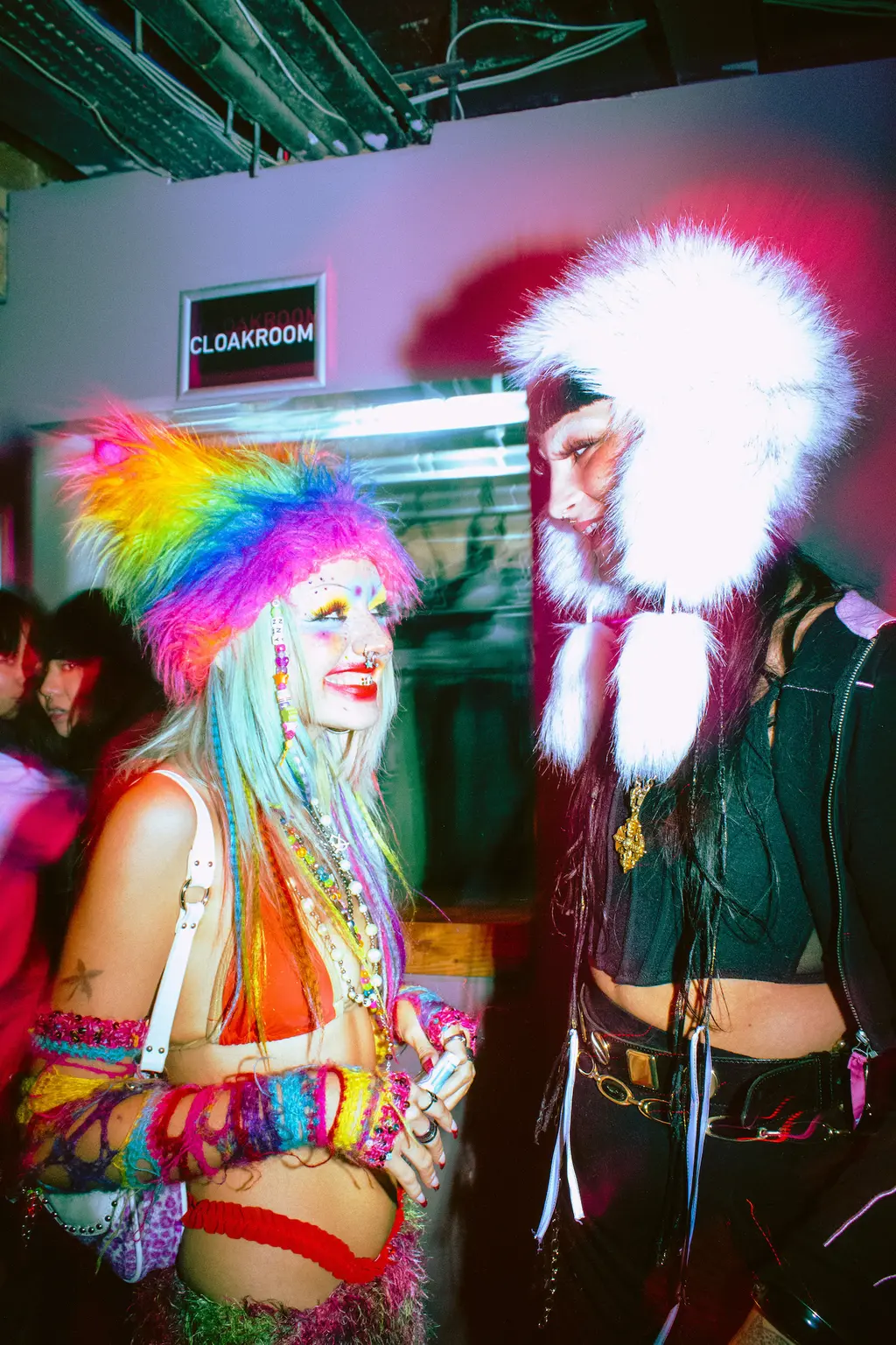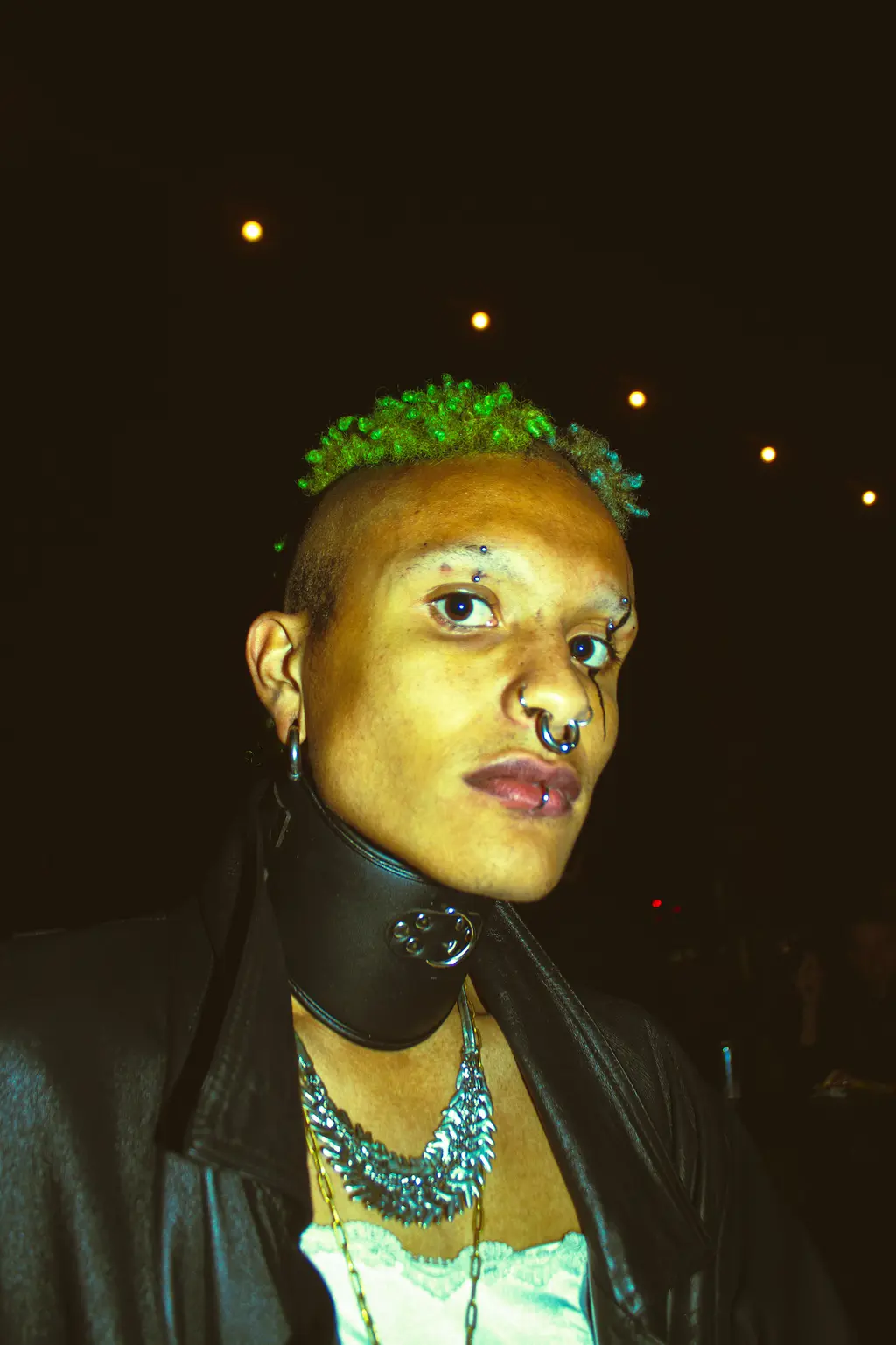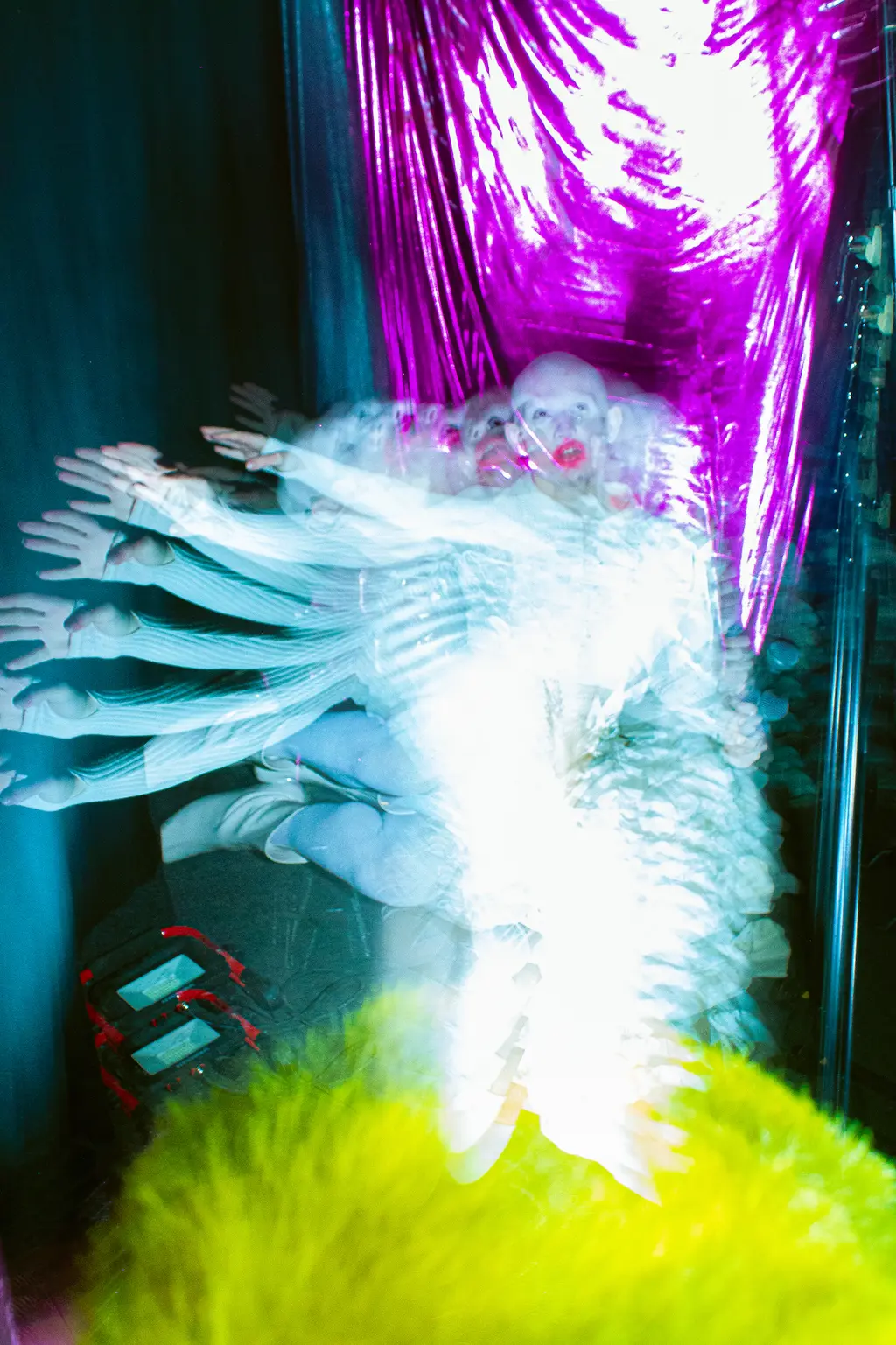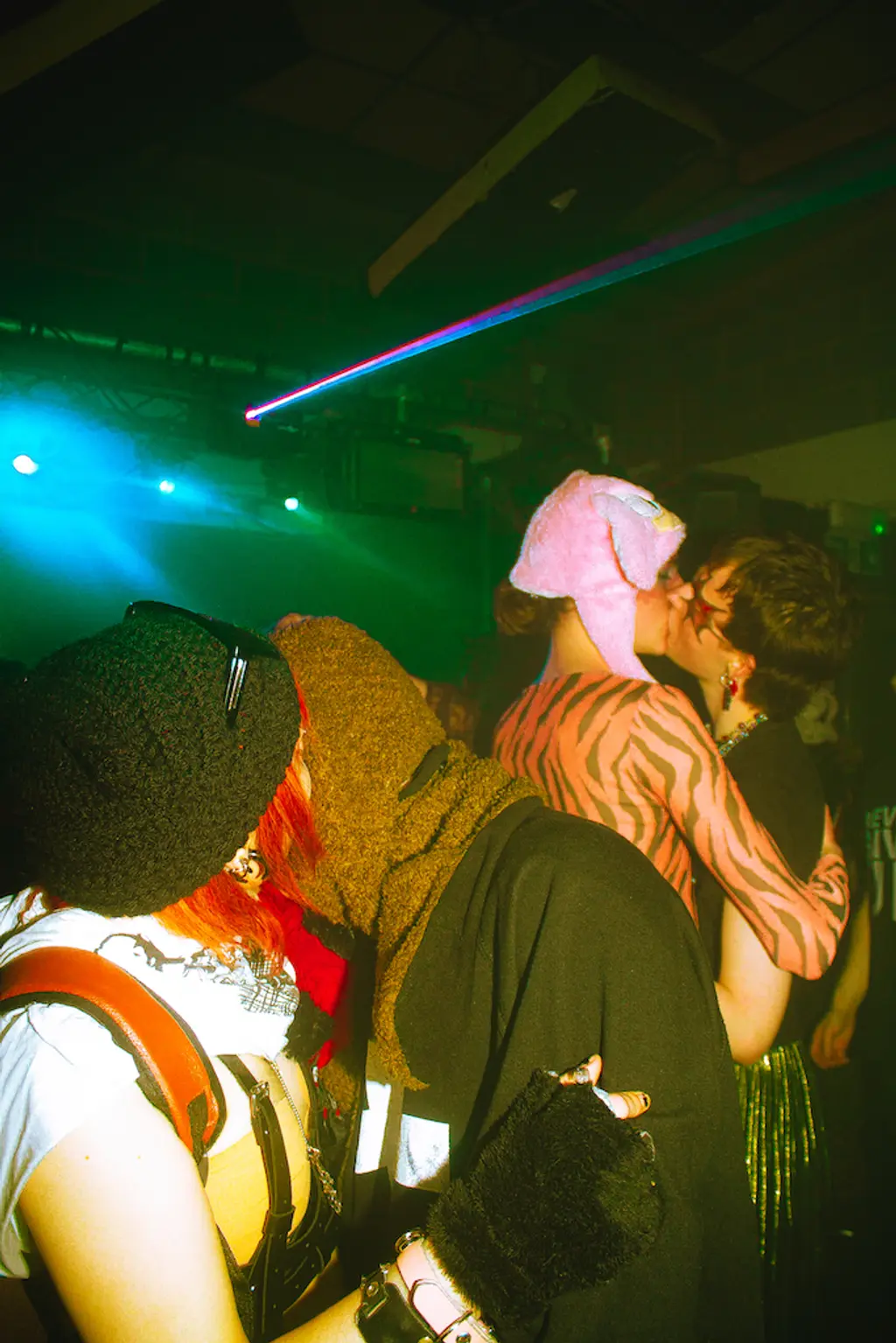Capturing the euphoria of London’s trans and queer ravers

Photographer Mia Evans put on an exhibition-slash-rave celebrating the spirit of the city’s queer community.
During Mia Evans’ first term at uni, the queer and trans photographer went all DIY and set up a makeshift exhibition in their student accommodation’s stairwell. The photos on show, depicting London’s queer rave scene, experimental portraits, nudes of trans friends and vibrant still-lifes, were stuck up on the large white walls as their fellow students walked up and down. Then, their friend pointed out how good the photos would look against a graffitied wall.
“Automatically we both thought of doing a squat [rave],” Evans, 18, says. “There’s something about being at a rave that exhibits you, specifically, being at a rave, that just seemed like a sick idea.”
Fast forward a couple of months and, in January this year, Evans put on So Far, a rave-slash-exhibition that brought together some 400 attendees from the queer and trans rave scene, with sets from 10 trans and queer DJs who performed throughout the night. And, of course, Evans’ documentation plastered the walls of the intimate underground venue, showing dressed-up ravers, dancefloor embraces and the ecstatic magic of queer love. The night was a huge success, with hardcore gabber soundtracking it ’til the early hours.
“For me, it became important to merge the photographs with hardcore gabber because the intensity and silliness of the music just seemed to match the colourful intensity of the photos,” Evans says. “We knew that if we were doing a rave, we were actually doing a rave, so it was no question to have 10 DJs all with hour slots. I love staying out ’til the early morning – it’s impossible to get home when a rave ends at 4am.” We couldn’t agree more.
Putting on a rave meant way more than simply hosting a night-out, though. For the photographer, it came from a “spiritual” place of liberation. Like for many of us, raves are a holy place – and only the properly devotional big weekenders get it.





“My favourite thing about going to a rave is being at one with the music,” they say. “There’s something so beautiful about dancing, feeling your body move and your mind [being] so at peace in such a chaotic environment.” And, if you haven’t tried it, Evans recommends sober raving for an altogether more astute experience.
“I really think more people should try raving sober – that’s when you find out what raves are actually good ones. There has to be good music, good people, a good location and it’s the perfect time,” they say. Like for so many trans and queer people, raving has been a way for Evans to connect with their community, which isn’t always easy for those who grow up outside of major cities such as London or Manchester.
“Being in the queer scene is so important for me as a trans, working-class person from the Midlands. I’d hardly met another trans person before, and then suddenly everyone around me was trans and queer. I often forget until I’m just walking around the streets of London how weirdly you get treated as a trans person, because the queer scene is so queer and really feels like home.”
It’s nights like So Far that highlight the need for safe spaces for the trans and queer community – which is needed now more than ever, during a time when anti-trans rhetoric is reported almost daily, and the ensuing war against LGBTQ+ people around the world is only getting more sinister.
“You just have to respect us, that’s all. Listen to us, support us, be there for us, and we’ll do the same for you,” Evans says. “We all just need to respect each other, and it’s not so simple – I know that. But people need to take a look inside of themselves and see where the hatred is being projected from, and work on healing the source. Also, please let us have rights. That would help, too.”
Given how well So Far went, it only made sense for Evans to follow it up with a photobook. Reality And Very Existence [R.A.V.E] puts the photographer’s work together in one slickly designed, spiral-bound package, showing the joy, love and euphoria of an unwavering community spirit.

Where did the title So Far come from?
The title So Far comments on the fact that this is just my work so far – all I want to do is just exhibit. But it also alludes to the idea of how far both myself and the rave scene have come, but also how we still have so far to go.
How did you manage to spread the word, with over 400 attendees showing up?
Instagram is the main one, most people find their raves on Instagram, and it just gets shared about. But I’d also stand in the packed smoking areas at the back of crowds in the raves where there was only a bar of signal, and just AirDrop the poster to everyone there, to make sure it really got about.
But also the act of word of mouth is not dead. I would photograph people at a rave, and then when exchanging Instagrams, I’d invite them to the exhibition. A big thing that helped was that it was free – people really love a free rave and I love it because it’s such a diverse crowd of people.
My favourite raves are squats because the craziest things happen – like, at the exhibition someone was just walking around fully naked, which I think perfectly describes the atmosphere of the work.
“Raving is a very spiritual experience for me, especially when raving sober”
How have your experiences of raving been so far?
I turned 18 last August, two weeks before coming to London at the beginning of September, and I hadn’t gone out back in Northampton. So I didn’t really have an experience with nightlife before coming into the rave scene at the end of September.
I was invited to my first rave and met what would turn out to be very important people for the first time, like @xen0morphgirl_ and @cultofshane, in which I’d never seen people who I thought looked so cool before. The night did become a blur and I completely forgot anything I said to them, but I just kept meeting them everywhere and everywhere, and so they started to consistently be in the photos, and then became very dear friends.
I don’t go clubbing, there are too many straight people, even at Heaven – especially at Heaven. I find no gravitation towards a club, I feel so restricted and judged for being myself, but at raves I feel so free. From my very first rave in September to the New Year I had managed to go to around 30 raves, sometimes doing three in one night, because I just feel so at peace with my surroundings.
What nights do you normally go to?
My uncomfortableness within clubs now means I only really find myself going to raves. I have a mixture of nights that often consists of spontaneous trips to squats or trans-run greatness like Cehennem, Arize and R u a goff. Gr1n is one that I’ve been going to since last Halloween, and seeing it grow each time is spectacular. K2Y and Slime-house have my heart.
I’ve also been to a mixture of nights and raves run by Alterum (@_alterum) which are some of the most memorable, just silly amazing nights to look out for. Honestly, you’ll probably just find me at anything I know about.
What’s your favourite thing about going to a rave, and how do you find the scene these days?
My favourite thing about going to a rave is being one with the music. There’s something so beautiful about just dancing and dancing and feeling your body move, and feeling your mind so at peace in such a chaotic environment. I go there to dance, and to photograph second.
As a photographer my biggest advice to other rave photographers is you shouldn’t be there if you wouldn’t be there without your camera, don’t just be an observer. I try to be a very grounded person, seeing raves not as a form of escapism, but rather as a tool of projecting negativity inside of you outwards into thin air through dancing.
Raving is a very spiritual experience for me, especially when raving sober. There’s something so shifting about dancing for eight hours to random heavy noises that really rejuvenates a person. I really think more people should try raving sober, that’s also when you find out what raves are actually good ones. There has to be good music, good people and a good location, and it’s the perfect time.
Being in the queer scene is so important for me as a trans person from the working class Midlands. I’d hardly met another trans person before, and then suddenly everyone around me was trans and queer. I often forget until I’m just walking about the streets of London how weirdly you get treated as a trans person, because the queer scene is so queer and really feels like home.
But of course the scene still has problems – naturally, despite there being so many amazing people, there’s still very problematic people in the scene, which comes with us being “imposters”. Sometimes you’re an imposter for a reason. I’m very vocal about how grounded and at peace I feel when at raves, that many of the most geish people I’ve met in my life come to me and tell me they feel like they don’t fit in, but it’s that none of us actually do.
I feel it’s about coming to terms with the fact that we’re all simply imposters being imposters together.

Much of the exhibition’s intention was to provide some positive light on trans creative, which is brilliant. How did you do this in the work?
My work focuses mainly on the queer rave scene, with many of my subjects being under the transgender umbrella. But I’m more than just a rave photographer. I do see myself as an artist, and I have a series of nude trans people, because I think presenting the raw trans body is something beautiful and unrepresented.
Outside of the photography itself, I made sure our favourite scene DJs were playing and nine out of 10 of them were trans identifying. Having many non-binary DJs playing, and dolls like Dextra Mandrake and LOVECAT too, made me feel so strong for our community, because trans DJs are the rock of the queer scene.
What can non-trans people do to help make a positive impact for the lives of trans people?
You just have to respect us, that’s all. Listen to us, support us, be there for us, and we’ll do the same for you. We all just need to respect each other. And it’s not so simple, I know that, but people need to take a look inside of themselves and see where the hatred is being projected from, and work on healing the source. Also, please let us have rights – that would help, too.
Are there plans to hold another exhibition/rave? And if so, what will you do next that you didn’t do the first time?
Of course there is. I’m releasing a photobook called Reality And Very Existence [R.A.V.E] and so of course I have to have a release exhibition rave. I don’t think I want to stop doing them anytime soon, but simply the future will hold what the future holds.
Order Reality And Very Existence [R.A.V.E] here (£10)






